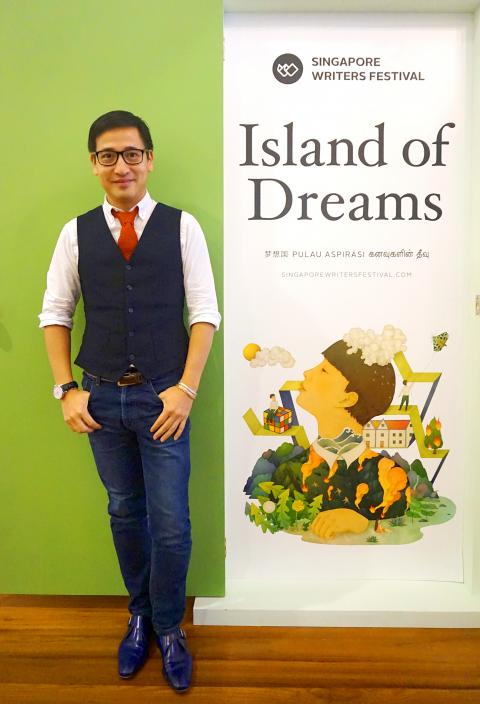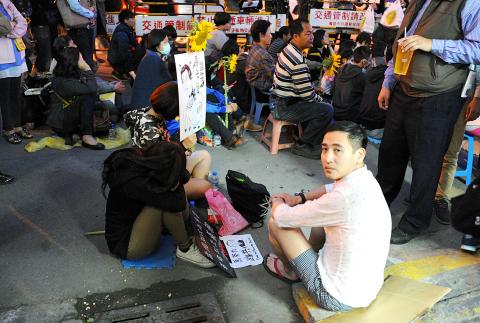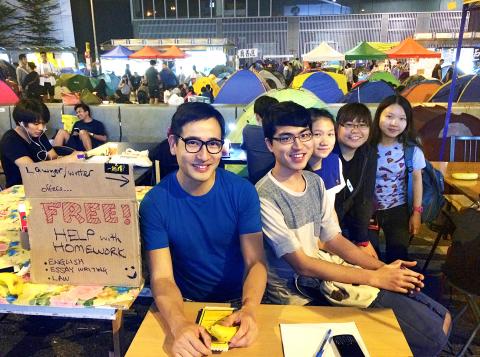It was the day after the Ma-Xi meeting — the historic meeting in Singapore between Taiwanese President Ma Ying-jeou (馬英九) and Chinese President Xi Jinping (習近平) and the first time that the top leaders from both sides of the Taiwan Strait have met in person — that I spoke with Hong Kong activist Jason Ng. The lawyer-turned-best-selling-author was signing books at the Arts House in Singapore where he was a featured speaker at the Singapore Writers Festival.
“In Hong Kong, the media calls it the Xi-Ma meeting,” Ng tells me.
Donning thick-rimmed glasses and a form-fitting navy blue vest over a neatly-pressed shirt and red tie, Ng’s soft-spoken, scholarly demeanor belies the fact that he’s one of Hong Kong’s most outspoken activists. In addition to being chosen as Hong Kong’s “Man of the Year” by Elle Men magazine in 2011 and participating in the “Umbrella movement” last year, Ng is also a columnist for the South China Morning Post and the author of the popular blog, As I See It, where he muses about Hong Kong’s most pressing social and political issues.

Photo: Dana Ter, Taipei Times
Ng says that the label, “Xi-Ma meeting,” is an indication of the amount of influence that China has come to exert over the media in Hong Kong. He adds that the perceived lack of a reliable press — especially the Chinese-language press — has led many Hong Kong residents to turn to blogs and social media for other perspectives on politics and current affairs.
BATTLE OF THE WITS, SORT OF
Earlier that day, Ng had spoken about citizen journalism at a panel discussion at the Singapore Writers Festival entitled “Tweet for Change,” which touched upon different ways that authors and journalists can use social media effectively. While he largely applauds social media for having the power to reach a mass audience in a shorter amount of time — he admits that his own blog has a wider readership than his articles because blogging is faster and more up-to-date — there’s still much to be wary of.

Photo courtesy of Jason Ng
Like the other panelists — also best-selling authors all of whom maintain a strong online presence — Ng believes that 140-character tweets and powerful images on Instagram have only fed into people’s short attention spans more.
“The problem is that whoever has a wittier phrase wins because someone who actually has a point to make may not be as creative,” he says.
Although it’s arguable that social media helped to rally support for social movements such as the “Umbrella movement,” Ng is skeptical of how much tangible progress is made when people are simply sitting at home and typing a few words or changing their profile pictures on Facebook.

Photo courtesy of Jason Ng
Then, there’s a new crop of commentators who keep the snide remarks rolling.
“The political environment in Hong Kong is so toxic these days, that after I post something, there will be a response after 10 seconds — it’s like, did you even read the article?” Ng says, to which the audience snickers.
THE TAIWAN CONNECTION
Speaking with Ng in person, he expresses a deep concern about the future of Hong Kong’s democracy. With the one year anniversary of the conclusion of the “Umbrella movement” coming up, Beijing has only continued to exert its own political agenda on the former British colony.
And with Taiwan’s presidential election next month, Taiwanese have a lot on their minds too. When I tell Ng that people in Taiwan are worried about ending up like Hong Kong — with the clamping down on freedom of speech and press — he agrees that it’s a legitimate concern.
There’s a saying, he adds: “Today’s Hong Kong is tomorrow’s Taiwan.”
Moreover, Ng believes that the Sunflower movement played an inspirational role to protesters in Hong Kong.
“It helped in terms of planting a seed,” Ng says. “Even if there wasn’t overt coordination, there was still a spiritual connection at least.”
Ng was actually on vacation in Kaohsiung when the Sunflower movement broke out. He participated in a sit-in there and was asked to give a speech but declined because he felt that his Mandarin wasn’t good enough. Nevertheless, he says it was “refreshing” to see such mass mobilization happen in Taiwan, rather than in a city like New York, where he wouldn’t have given it a second thought.
“I remember telling myself that this is what it must have felt like to be in Tiananmen Square in 1989,” Ng tells me.
When I ask him why he thinks the foreign media didn’t give the Sunflower movement as extensive coverage as it did with the Umbrella revolution, his reply is simple: “there was nothing sexy.”
More often than not, the press is sensation-driven. While the Sunflower movement was largely non-violent, consisting of mostly peaceful protesters occupying the legislature to show their defiance of the cross-strait service trade agreement with China, the protests in Hong Kong — which took place on the streets and involved the police using tear gas on protesters — was far more visible.
“Some guy in Tennessee wouldn’t be interested in some people sitting inside a building in Taiwan to protest a trade pact,” Ng says.
THE COFFEE SHOP DREAM
Although Ng might have his qualms about Hong Kong’s future, he is hopeful for Taiwan. Not only did the Sunflower movement make possible the nine-in-one elections, he says, which led to the Chinese National Party (KMT) losing the Taipei mayorship, but Democratic Progressive Party (DPP) presidential candidate Tsai Ing-wen (蔡英文) also seems more interested in developing the economy rather than fixating on cross-strait relations.
Politics aside, people from Hong Kong have increasingly come to see Taiwan as an ideal place to live and work. Citing figures from a TVB Evening News report, Ng says the percentage of people from Hong Kong applying for permits to live in Taiwan increased by 64 percent from 2013 to last year.
Ng says this is because they are attracted to the laidback lifestyle and entrepreneurial work ethic that Taiwan has to offer. It wasn’t the case a decade ago when people from Hong Kong thought Taipei — with its grimy sidewalks and lack of skyscrapers — had much catching up to do with other Asian cities.
“There’s the allure of a slower pace of life,” Ng says. “Some of the most popular books in bookstores around Hong Kong are about how to move to Taiwan, and people are dreaming of opening coffee shops in Taipei.”
Ng has to rush off to another panel discussion and I’m wondering how he manages to look so immaculate despite the torrid Singapore heat. Nevertheless, his words left me thinking that while we may not be as zesty as activists in Hong Kong, at least we’re brewing good coffee.

Oct. 27 to Nov. 2 Over a breakfast of soymilk and fried dough costing less than NT$400, seven officials and engineers agreed on a NT$400 million plan — unaware that it would mark the beginning of Taiwan’s semiconductor empire. It was a cold February morning in 1974. Gathered at the unassuming shop were Economics minister Sun Yun-hsuan (孫運璿), director-general of Transportation and Communications Kao Yu-shu (高玉樹), Industrial Technology Research Institute (ITRI) president Wang Chao-chen (王兆振), Telecommunications Laboratories director Kang Pao-huang (康寶煌), Executive Yuan secretary-general Fei Hua (費驊), director-general of Telecommunications Fang Hsien-chi (方賢齊) and Radio Corporation of America (RCA) Laboratories director Pan
The consensus on the Chinese Nationalist Party (KMT) chair race is that Cheng Li-wun (鄭麗文) ran a populist, ideological back-to-basics campaign and soundly defeated former Taipei mayor Hau Lung-bin (郝龍斌), the candidate backed by the big institutional players. Cheng tapped into a wave of popular enthusiasm within the KMT, while the institutional players’ get-out-the-vote abilities fell flat, suggesting their power has weakened significantly. Yet, a closer look at the race paints a more complicated picture, raising questions about some analysts’ conclusions, including my own. TURNOUT Here is a surprising statistic: Turnout was 130,678, or 39.46 percent of the 331,145 eligible party

The classic warmth of a good old-fashioned izakaya beckons you in, all cozy nooks and dark wood finishes, as tables order a third round and waiters sling tapas-sized bites and assorted — sometimes unidentifiable — skewered meats. But there’s a romantic hush about this Ximending (西門町) hotspot, with cocktails savored, plating elegant and never rushed and daters and diners lit by candlelight and chandelier. Each chair is mismatched and the assorted tables appear to be the fanciest picks from a nearby flea market. A naked sewing mannequin stands in a dimly lit corner, adorned with antique mirrors and draped foliage

The election of Cheng Li-wun (鄭麗文) as chair of the Chinese Nationalist Party (KMT) marked a triumphant return of pride in the “Chinese” in the party name. Cheng wants Taiwanese to be proud to call themselves Chinese again. The unambiguous winner was a return to the KMT ideology that formed in the early 2000s under then chairman Lien Chan (連戰) and president Ma Ying-jeou (馬英九) put into practice as far as he could, until ultimately thwarted by hundreds of thousands of protestors thronging the streets in what became known as the Sunflower movement in 2014. Cheng is an unambiguous Chinese ethnonationalist,